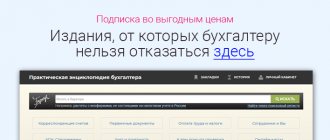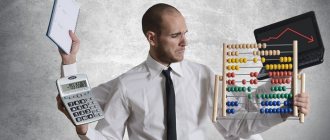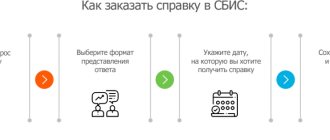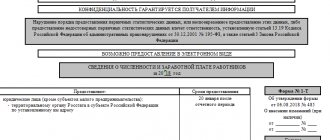A little theory. How to switch to simplified
To have an idea of how to switch to the simplified tax system, you need to remember the following: the conditions for switching to the simplified tax system require submitting a corresponding notification to the tax office at your location (residence). This must be done no later than December 31 or within 30 days from the date of state registration. This notice should include the following information:
- planned object of taxation (all income or income that remains after deducting the expenses allowed by the Tax Code of the Russian Federation);
- residual value of fixed assets calculated as of October 1 of the current year;
- total income for 9 months of current income.
The transition from OSNO to simplified tax system in 2019-2020, as before, is carried out on the basis of a notification in form 26.2-1. The transition from the OSN to the simplified tax system involves choosing one of two bases for taxation with a single tax. This can be either all income received or income less expenses incurred. Accordingly, in these two cases there will be different rates for the single tax. If all income is taken as a basis, you will have to pay a single tax on it at a rate of 6% (subjects of the Russian Federation can reduce the rate to 1%). When the base for the single tax is net income, it is paid in the amount of 5 to 15% (the rate also depends on the specific region of the Russian Federation).
Restoration of VAT on inventories
Organizations using the simplified tax system are not recognized as payers of value added tax, with the exception of value added tax payable when importing goods into the customs territory of the Russian Federation ( clause 2 of article 346.11 of the Tax Code Russian Federation ).
Clause 1 of Article 171 of the Tax Code of the Russian Federation determines that the taxpayer has the right to reduce the total amount of VAT calculated in accordance with Article 166 of the Tax Code of the Russian Federation by the tax deductions established by Article 171 of the Tax Code of the Russian Federation.
When purchasing goods (work, services), including fixed assets and intangible assets, by persons who are not VAT taxpayers, the VAT amounts presented to the buyer are taken into account by him in the cost of such goods (work, services), including fixed assets and intangible assets assets ( clause 3, clause 2, article 170 of the Tax Code of the Russian Federation ).
If the taxpayer accepts the specified amounts of VAT for deduction or reimbursement in the manner prescribed by Chapter 21 of the Tax Code of the Russian Federation , the corresponding amounts of VAT are subject to restoration and payment to the budget.
Based on the above provisions of Chapter 21 of the Tax Code of the Russian Federation, the Ministry of Finance of Russia and the Federal Tax Service of Russia conclude that it is necessary to restore and pay to the budget the amounts of VAT previously accepted for deduction on goods (work, services) used in production activities after the organization’s transition to the simplified tax system.
Position of the tax authorities
On the issue of restoring VAT on the balance of goods, the opinion of the tax authorities is based on subparagraph 3 of paragraph 2 of Article 170 of the Tax Code of the Russian Federation, according to which, when purchasing goods by persons who are not taxpayers in accordance with Chapter 21 of the Tax Code of the Russian Federation or are exempt from fulfilling the taxpayer’s duties for calculating and payment of tax, the amounts of VAT presented for payment are taken into account in the cost of goods (letter of the Department of Tax Administration for Moscow dated 03/09/2003 No. 24-11/15029).
The position of the tax authorities on the issue of restoring VAT on fixed assets is that after the transition to a simplified taxation system, the amount of VAT previously accepted for deduction in accordance with Articles 171 and 172 of the Tax Code of the Russian Federation, as a share of the under-depreciated value of the property, must be restored and paid in budget (clause 2, clause 2 of the Appendix to the letter of the Department of the Ministry of Taxes and Taxes for Moscow dated April 2, 2003 No. 11-15/17644).
We will demonstrate the fulfillment of these requirements using specific examples performed in the “Simplified Taxation System” configuration for “1C:Enterprise 7.7”.
Restoration of VAT on remaining goods
Example 1
| In October 2003, Romashka LLC purchased 200 carved hangers at a price (excluding VAT) of 500 rubles. a piece. The price of the goods was 100,000 rubles, VAT (20%) - 20,000 rubles, total - 120,000 rubles. The VAT amount was accepted for deduction. By the end of 2003, 185 pieces were sold and as of December 31, 2003, there were 15 hangers left in the warehouse. |
In accounting for the period of work under the general taxation regime, there will be transactions related to the receipt of goods and VAT accounting (see Table 1).
Table 1
| date | Contents of operation | Postings | Sum | Required documents | |
| Dt | CT | ||||
| 01.10.2003 | Paid the goods to the supplier | 60 | 51 | 120000 | Payment order |
| 01.10.2003 | The goods have been received | 41 | 60 | 100000 | Invoice |
| 01.10.2003 | VAT allocated on paid goods | 19.3 | 60 | 20000 | Invoice |
| 01.10.2003 | Accepted for deduction, VAT amounts paid to the supplier | 68.2 | 19.3 | 20000 | Invoice |
On the date preceding the start of accounting under the simplified taxation system in the program, we will manually perform the operation “Entering initial balances” (see Fig. 1), consisting of 2 transactions:
- by debit of subaccount 41.2 “Goods, the value of which is accepted for tax purposes” (quantity and value) in correspondence with auxiliary account 00;
- on the debit of subaccount MX.2 “Accounting for inventory items by storage location - goods”, indicating only the quantity.
Rice. 1. The operation of entering product balances.
The amount of VAT accepted for deduction when purchasing goods, attributable to the balance of goods, will be:
20000/200x15=1500 rub.
This amount is subject to payment to the budget. To account for it, we will also manually enter an operation (see Fig. 2), consisting of 3 transactions:
Debit 19 “VAT on purchased assets” Credit 68.2 “Value added tax” - restoration of the VAT amount on the balance of goods; Debit 41.2 “Goods, the value of which is accepted for taxation” Credit 19 “VAT on acquired values” - assigning the amount of VAT to the cost of the goods; Debit of the off-balance sheet VAT account “Input VAT not accepted as expenses” - accounting for input VAT.
Rice. 2. Operation of VAT recovery on the balance of goods
Now for organizations that have chosen “Income reduced by the amount of expenses” as an object of taxation, when selling the goods, the goods will be written off at cost, taking into account the restored VAT: (7500+1500)/15=600 rubles. a piece. Moreover, if on the issue of recognizing expenses on goods, the enterprise also takes a cautious position, consistent with the opinion of the Ministry of Taxes of Russia, and in the “Information about the organization” (menu “Service”) on the “Taxation” tab, the option of recognizing expenses on goods is set - after payment by the buyer , then expenses on goods will be accepted for tax purposes - in the debit of account N02.2 “Other expenses taken into account when calculating the single tax”, only after the buyer pays for the goods when posting the “Statement” document (menu “Documents”).
The corresponding entries will be generated in the “Income and Expenses Accounting Book” (menu “Reports”) (see Fig. 3).
Rice. 3. Book of income and expenses
The restored amount of VAT in accordance with the order of the Ministry of Taxes of Russia dated January 21, 2002 No. BG-3-03/25 should be indicated in the tax return for value added tax (Menu “Reports/Regulated reports/Tax reporting/VAT”) in section 2.1 “Calculation total amount of tax" on line 370 "Amounts of tax paid by the taxpayer on goods (work, services) accepted for accounting, including fixed assets and intangible assets previously included in tax deductions and subject to restoration." The same amount will automatically be reflected in lines 390 “Total amount of VAT calculated for payment to the budget for a given tax period” and 430 “Total amount of VAT calculated for payment to the budget.”
Restoration of VAT on fixed assets
Example 2
| In August 2003, Romashka LLC purchased and put into operation a fixed asset - a grinding machine. The price of the operating system was 18,400 rubles, VAT (20%) - 3,680 rubles, total - 22,080 rubles. The VAT amount was accepted for deduction. The useful life of the OS is 60 months. |
The accounting records for the period of operation under the general taxation regime (GRT) should have contained the transactions presented in Table 2.
table 2
| date | Contents of operation | Postings | Sum | Required documents | |
| Dt | CT | ||||
| 10.08.2003 | Paid the supplier's invoice | 60 | 51 | 22080 | Payment order |
| 13.08.2003 | OS object accepted for accounting | 08.3 | 60 | 18400 | Invoice |
| 13.08.2003 | We allocated VAT on the fixed assets item paid and accepted for accounting | 19.1 | 60 | 3680 | Invoice |
| 13.08.2003 | Accepted for deduction, the amounts of “input” VAT paid to the supplier | 68.2 | 19.1 | 3680 | Invoice |
| 14.08.2003 | The purchased fixed asset was put into operation | 01 | 08.3 | 18400 | Certificate of acceptance and transfer of fixed assets |
| 14.08.2003 | Depreciation was calculated for September, October, November and December 2003. | 20 | 02 | 1226.67 | Accounting certificate-calculation |
We begin entering information on fixed assets by creating a new element - “grinding machine” in the “Fixed Assets” directory (menu “Directories”). Let us first fill out only the first tab “General information” (see Fig. 4), noting the sign that the fixed asset is “subject to depreciation” and the sign that it is necessary to “accrue depreciation” on it.
Rice. 4. The “General Information” tab of the “Fixed Assets” directory
On the date preceding the start of accounting in the program, using a manual operation in correspondence with auxiliary account 00, we will enter the balances of the fixed asset (see Fig. 5):
- the initial cost of fixed assets (excluding VAT) - by debit of subaccount 01.1 “Fixed assets in the organization”;
- accrued depreciation during operation according to ORN, equal to the amount of 18400/60x4= =1226.67 rubles. — on the credit of subaccount 02.1 “Depreciation of fixed assets recorded on account 01.”
Rice. 5. Operation of entering balances for a fixed asset
We will also manually enter entries for VAT restoration (see Fig. 6):
Debit 19 “VAT on purchased assets” Credit 68.2 “Value added tax” - restoration to payment to the budget of the amount of VAT previously allocated to settlements with the budget; Debit 01.1 “Fixed assets in the organization” Credit 19 “VAT on acquired assets” - assigning the restored amount of VAT to the cost of fixed assets; Debit 68.2 “Value added tax” Credit 02.1 “Depreciation of fixed assets accounted for in account 01” - accounting for the share of recovered VAT attributable to the already depreciated part of the cost of fixed assets, equal to 3680/60x4 = 245.33 rubles.
Rice. 6. Operation of VAT restoration on a fixed asset
Thus, the amount of VAT previously accepted for deduction in relation to the residual value of the fixed asset is subject to payment to the budget (credit to subaccount 68.2). In this example, it is equal to the amount of 3680-245.33 = 3434.67 rubles.
Let us now return to filling out the “Accounting” and “Tax Accounting” tabs in the “Fixed Assets” directory (see Fig. 7), indicating as the initial cost of fixed assets, including VAT (the amount in the debit of subaccount 01.1) and the amount of accrued depreciation, also with including VAT (amount on the credit of subaccount 02.1). By clicking the “Show payments” button, we will add a line with the date and amount of payment for the fixed asset.
Rice. 7. Tab “Tax Accounting” of the directory “Fixed Assets”
In accordance with paragraph 3 of Article 346.16 of the Tax Code of the Russian Federation, the residual value of the paid fixed asset is included in expenses that reduce income when determining the tax base. They are distributed across tax periods based on their useful life. In particular, for OS with a useful life from 3 to 15 years inclusive, during the first year of application of the simplified tax system - 50%, the second - 30% and the third - 20%. In this case, during the tax period, expenses are accepted in equal shares for the reporting periods. Recognition of expenses for the acquisition of fixed assets is carried out using the document “Month Closing” (menu “Documents”) in the last month of the reporting period.
The calculation of expenses for the acquisition of fixed assets accepted when calculating the tax base for a single tax (see Fig. 8) can be generated by setting the appropriate attribute in the “Income and Expenses Accounting Book” dialog box (the “Reports” menu).
Rice. 8. Calculation of expenses for the acquisition of fixed assets accepted for tax accounting
The restored amount of VAT, as in the previous example, should be indicated in the tax return for value added tax in section 2.1 “Calculation of the total tax amount”.
"1C:Servistrend" Tel., 748-63-53, 962-64-00 E-mail (general)
Recovering VAT on fixed assets
For the same reasons, an organization, when switching to a special simplified tax system regime, must restore VAT on fixed assets, which was previously declared for deduction ( clause 8 of article 145 , clauses 1 , 2 , 6 , 7, clause 3 of article 170 , p. 3 Article 171.1 of the Tax Code of the Russian Federation ).
In general, the amount of “input” VAT on fixed assets, which was previously presented for deduction from the budget, is restored in proportion to the residual value of the fixed assets ( clause 3 of Article 170 of the Tax Code of the Russian Federation ) according to the following formula:
Amount of VAT to be restored = VAT previously accepted for deduction on fixed assets X Residual value of fixed assets / Initial cost of fixed assets
In this case, the calculation of the amount of tax subject to restoration on depreciable property is made taking into account the residual value of such property, formed according to accounting data.
VAT on remaining goods
It can often happen that in the company’s warehouse there are remnants of goods purchased under the OSN, but not used. Then the amount equal to the deduction is restored. It represents the amount by which the total payment is reduced. A detailed list of deductions is given in the Tax Code.
These include amounts presented when purchasing goods in the Russian Federation, or funds paid upon import, amounts for business travel expenses, entertainment expenses, etc. Deductions are shown in the third section of the declaration.
The period of restoration of VAT, previously legally claimed for deduction, on fixed assets and inventory balances
Restoration of VAT amounts paid to suppliers of materials, goods and fixed assets and previously legally accepted for deduction is made in the last tax period before the transition to the simplified tax system.
In the situation under consideration, in December of the current period, the organization must make an entry on the credit of account 68 “Calculations for taxes and duties” in correspondence with account 19 “Value added tax on acquired assets” (Instructions for using the Chart of Accounts for accounting financial and economic activities of organizations, approved by Order of the Ministry of Finance of Russia dated October 31, 2000 N 94n ).
Results
Restored VAT when switching to the simplified tax system is an additional expense for an enterprise or individual entrepreneur from an economic point of view, which should be taken into account when deciding to change the taxation system.
Sometimes these costs can be significant. In order not to overpay VAT during such a transaction, you should carefully study the law and possible subtleties relating to the situations of a particular taxpayer. You can find more complete information on the topic in ConsultantPlus. Free trial access to the system for 2 days.
The procedure for accounting for VAT previously legally claimed for deduction on fixed assets and inventory balances
Based on clause 6 of the Accounting Regulations “Accounting for Inventories” PBU 5/01, approved by Order of the Ministry of Finance of Russia dated 06/09/2001 N 44n, clause 8 of the Accounting Regulations “Accounting for Fixed Assets” PBU 6/01, approved By Order of the Ministry of Finance of Russia dated March 30, 2001 N 26n , the amounts of VAT restored for payment are included, respectively, in the actual cost of materials and in the initial cost of fixed assets by entries on the credit of account 19 in correspondence with accounts 10 “Materials”, 01 “Fixed assets”.
At the same time, the restored amount of VAT is not included in the cost of goods, but is taken into account as part of other expenses in accordance with Art. 264 Tax Code of the Russian Federation. Thus, with a change in the taxation system, it is necessary to restore the VAT previously claimed for deduction on fixed assets to the balances of inventories.
It should also be remembered that VAT is restored at the rate that was in effect at the time of acquisition of this or that property.
When switching to the simplified tax system, expenses take into account the paid cost of the remaining raw materials, supplies, work in progress and finished products ( Letter of the Ministry of Finance dated October 30, 2009 N 03-11-06/2/233 ).
But the cost of goods on the simplified tax system is written off only upon sale ( clause 2, clause 2, article 346.17 of the Tax Code of the Russian Federation ).
The residual value of fixed assets is written off in a special manner ( clause 4, clause 2, article 346.17 of the Tax Code of the Russian Federation ).
Example.
The organization has decided to switch to a simplified taxation system starting next year.
As of December 31 of the current year, materials worth 40,000 rubles are listed on the organization’s balance sheet. and goods worth 60,000 rubles, as well as fixed assets purchased in the current year.
The initial cost of the fixed asset is 500,000 rubles. (without VAT). The residual value of the fixed asset at the end of the current year was 250,000 rubles.
When purchasing a fixed asset, VAT was declared deductible at a rate of 20% in the amount of 100,000 rubles.
Then the amount of VAT subject to restoration in the fourth quarter of the current year will be equal to 50,000 rubles. (RUB 100,000 x RUB 250,000 / RUB 500,000).
In the accounting of the organization, the restoration of VAT accepted for deduction when purchasing materials and fixed assets, in connection with the transition to a simplified taxation system, should be reflected as follows:
| Contents of operations | Debit | Credit | Sum, rub. | Primary document |
| In December of this year | ||||
| Reinstated for payment in budget VAT amount with residual value fixed assets | 19 “VAT on the acquisition of fixed assets” | 68/VAT | 50 000 | Accounting certificate-calculation |
| Reinstated for payment in budget VAT amount with cost of materials (40 000×20%) | 19 “VAT on purchased inventories” | 68/VAT | 8 000 | Accounting reference-calculation |
| Reinstated for payment in budget VAT amount with cost of goods (60 000×20%) | 91-2 | 68/VAT | 12 000 | Accounting reference-calculation |
| For the restored amount VAT increased initial cost fixed assets | 01 | 19 “VAT on the acquisition of fixed assets” | 50 000 | Inventory object registration card fixed assets |
| For the restored amount VAT increased actual cost of materials | 10 | 19 “VAT on purchased inventories” | 20 000 | Card inventory accounting |
Purchase of materials, semi-finished products, goods for resale
Submit your VAT return using the Kontur.Accounting web service. The system itself will generate a declaration based on primary documents and check it before sending. Get free access for 14 days
On October 3, 2022, Everest LLC purchased materials in the amount of RUB 472,000. VAT including amounted to 72,000 rubles. and was presented for deduction in full. In our case, the rate was 18%, but for some categories of goods, works and services it can be equal to 0% or 10%. By the end of the year, only half of the purchased raw materials were consumed. This means that the tax amount on the accounting value of the balance of materials is 200,000 rubles. will need to be restored in the current quarter.
The restored tax amount under the simplified system will be equal to: 200,000 * 0.18 = 36,000 rubles. The second calculation option is to multiply the entire tax previously claimed for deduction by the share of materials unspent as of December 31, 2022 (here – ½).
The controversial point is the presence of a balance at the time of transfer of inventories of manufactured products. On the one hand, VAT on the materials for its production was deducted, but the products themselves were not sold. On the other hand, the raw materials have already been used up. The practice of court decisions shows that in such a situation there is no need to restore VAT.
Errors after switching to special mode
To conclude the article, let’s look at examples of violations after the transition to a special regime:
After the transition to the simplified tax system, payments received from buyers for goods, works, services sold on the simplified tax system were included in income
Based on paragraph 1 of Article 346.25 of the Tax Code of the Russian Federation , organizations that, before the transition to a simplified taxation system when calculating corporate income tax, used the accrual method, when transitioning to the simplified tax system, follow the following rules:
— on the date of transition to the simplified tax system, the tax base includes amounts of funds received before the transition to the simplified tax system in payment under contracts, the execution of which the taxpayer carries out after the transition to the simplified tax system ( subparagraph 1 of paragraph 1 of Article 346.25 of the Tax Code of the Russian Federation ).
At the same time subparagraph 3 of paragraph 1 of Article 346.25 Code of the Russian Federation provides that funds received after the transition to the simplified tax system are not included in the tax base if, according to the rules of tax accounting using the accrual method, these amounts were included in income when calculating the tax base for corporate income tax .
Thus, after switching to the simplified tax system, do not count payments received from buyers for goods, works, services sold on the simplified tax system as income.
Example.
The organization, within the framework of the simplified tax system, shipped goods to the buyer, payment for which will be received by the organization after the transition to the simplified tax system.
Since, on the basis of paragraph 1 of Article 271 of the Tax Code of the Russian Federation , the organization took into account the income from the sale of these goods as part of the application of the OSN, when receiving payment for the goods from the buyer, funds from their sale are not included in the tax base for the “simplified” tax.
Restoring VAT amounts when switching to the simplified tax system: legal grounds
According to the accepted rules, “simplers” are not VAT payers. But, since after the transition from OSNO the company still has assets at its disposal (goods, inventory items, fixed assets, intangible assets), upon acquisition of which the tax was reimbursed from the budget, the legislator (clause 2, clause 3, article 170 of the Tax Code of the Russian Federation) provides for the obligation to restore VAT. In essence, this term refers to the accrual of tax that was once offset (reimbursed from the budget).
There is no need to restore VAT on the value of assets for which no deduction was claimed, or they were acquired without “input” tax. VAT restoration under the simplified tax system is carried out on the balances of property recorded in the balance sheet of the enterprise on the date of transition to the simplified tax system. This should be done in the last quarter of activity on OSNO, reflecting the amount of restored VAT in the tax return. It is indicated in the 3rd section: in line 090 - VAT at the current standard rates, in line 100 - tax at a rate of 0%, and in line 080 - the total amount of the restored tax.
For your information! When an enterprise returns from the simplified tax system to OSNO, it will not be possible to claim a deduction for the already restored VAT a second time - this right is lost (letter of the Ministry of Finance dated March 26, 2012 No. 03-07-11/84).
After the transition to the simplified tax system, interest received under loan agreements was included in income
As part of the application of the SOS, the organization issued an interest-bearing loan to another organization.
According to the general rule of paragraph 6 of Article 250 of the Tax Code of the Russian Federation, the creditor company located on the OSN reflects interest due from the borrower as part of its non-operating income at the end of each month of the corresponding reporting (tax) period, regardless of the date (terms) of their payment, provided for by the contract. Consequently, the organization has already taken such non-operating income into account in its income while still on the OSN.
Having received such interest from the borrower under the simplified tax system, she should not take these funds into account in the tax base under the simplified tax system.
A similar conclusion is confirmed by Letter of the Federal Tax Service of Russia dated August 14, 2015 N GD-4-3/ 14371 “On sending clarifications on certain issues of creating reserves for doubtful debts by microfinance organizations.”




